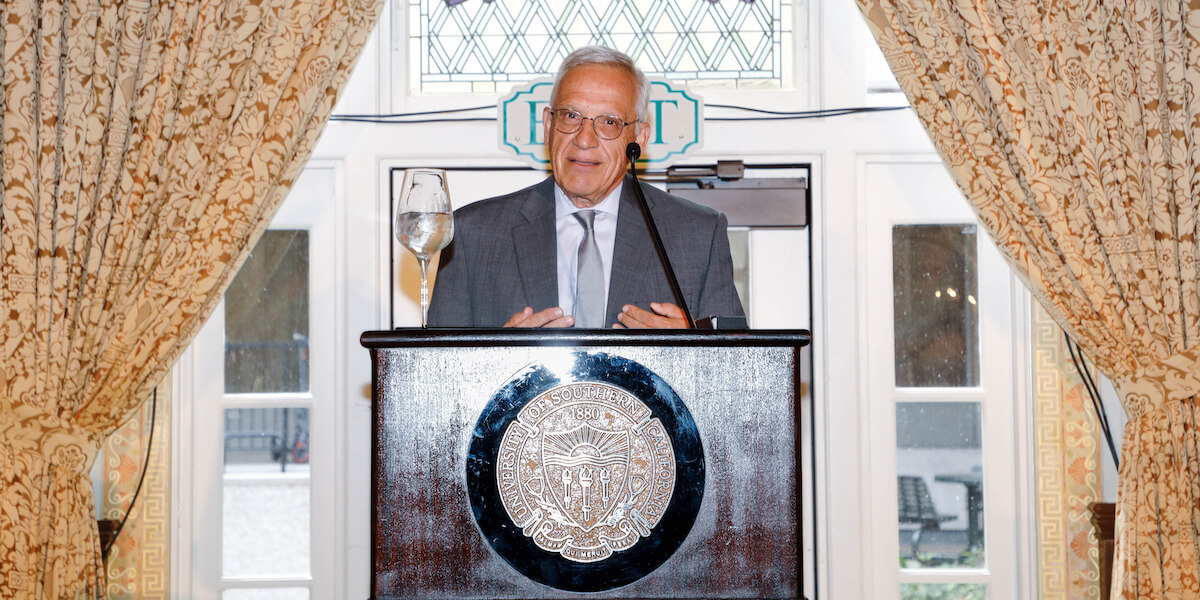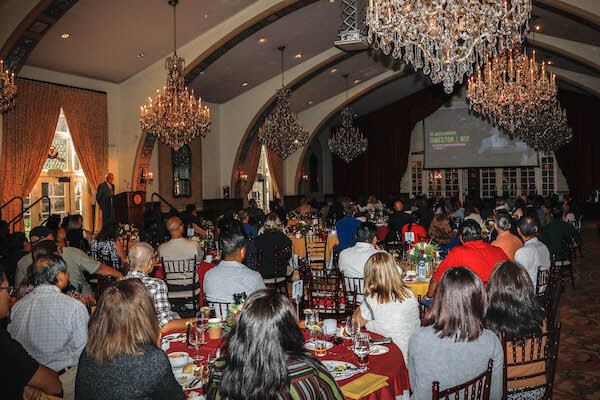
Dean Yannis C. Yortsos (Photo/Angel Ahabue)
In his annual address on the State of the School, Dean Yannis C. Yortsos discussed how the school responds to the accelerating pace of technology, the inflection points presented by AI and biotechnology, and the opportunities of interdisciplinary endeavors. He mentioned that with its long-ago articulated visions to “hug the exponential” and “engineering+”, and with its new initiatives on the Frontiers of Computing and Biomedical Engineering, USC Viterbi is positioned well for a future of constant change.
“USC Viterbi enters the fall 2023 year with healthy enrollments, fiscal soundness, brilliant research and scholarship, abiding commitment from our supporters, and exciting new initiatives,” he said.
In his Sept. 27 address at Town & Gown, Yortsos highlighted significant accomplishments in all these directions, including two historic naming gifts for the Alfred E. Mann Department of Biomedical Engineering and Thomas Lord Department of Computer Science; the launch of the $1 billion Frontiers of Computing initiative, the Department of Defense’s recent selection of USC as one of eight national hubs to develop and mass produce advanced microchips; and the launch of a significant new initiative in sustainability, through a USC-led Water Reuse Consortium.
The dean noted that these initiatives have taken place against the backdrop of AI-fueled exponential change and inflection points, singular moments that represent a definitive break with the past. In addition to the significant initiatives in the “buckets” of Sustainability, Health, Security and Enriching Life, he mentioned the school’s advances in helping our students develop outstanding character in addition to outstanding competence, through the new Engineering in Society Program, thus creating trustworthiness.
“We at USC Viterbi are ready to adapt, solidify, and lead a world, where change is constant, where a new phase of the state of the art must be defined and built, where boundaries are permeable and stretched,” he said.
In his address, Yortsos also highlighted some of the characteristics of the entering class, with students coming from 37 states, with Washington, New York, and Illinois the most represented after California, and from 20 countries. With this year’s acceptance rate less than 8%, and with more than 40% of those admitted having earned a perfect 4.0 GPA in high school, more than one-quarter are the first in their families to attend college. And for the fifth year in a row, the entering class reached gender parity, with 49% women. A stellar transfer class resulted in 145 students enrolling. Said Yortsos: “The incoming class is the best in the school’s history. Of course, I did say the same to last year, and I can reasonably predict that we will say the same thing next year!”
In addition, many non-engineering USC students are enrolled in courses at the Information Technology Program, or ITP, which offers USC’s most popular minor, applied analytics, with nearly 500 students. ITP will play a central role in increasing digital fluency at USC, a key pillar of the Frontiers of Computing initiative.
The following are modified excerpts from Dean Yortsos’ remarks:
<>
On the Naming Gifts for the Departments of Biomedical Engineering and Computer Science
In the spring of 2023, USC Viterbi received two extraordinary gifts: They resulted in the naming of the Department of Biomedical Engineering as the Alfred E. Mann Department of Biomedical Engineering; and the naming of the Department of Computer Science as the Thomas Lord Department of Computer Science. We are indebted to President Folt and her team for recognizing the important role USC Viterbi plays and will play in today’s extraordinary times and the trust they extended to the school in the naming of the two departments. By honoring biomedical engineering pioneer Al Mann and engineering entrepreneur Thomas Lord, these two transformative moments strengthen even further the prowess of the school in the two large domains of health and enriching life described above. They also emphatically highlight and, in an ingenuous way, USC’s launch of two university-wide key moonshots in Health and in Frontiers of Computing.
The Mann naming gift will allow us to further strengthen all facets of our BmE program, from undergraduate education to pioneering research. And in strong partnership with the expertise of many of our faculty in the intersection (Venn diagram) of medicine and engineering, it will enable innovative new initiatives with the Keck School of Medicine of USC and other health sciences. Such initiatives will leverage technologies from AI to nanoparticles to immunotherapy to genomics- to address and solve fundamental medical problems.
On the Frontiers of Computing
In 1972, USC launched the Information Sciences Institute (ISI), which helped develop, design, and run the Internet, including communications protocols that remain fundamental to this day. ISI engineers created the .com and developed the Voice over Internet Protocol — Zoom, anyone? — and launched the first operational quantum computer of any university worldwide. Last year we celebrated ISI’s 50th anniversary.
Building on this combined excellence in computing, which also includes the Institute for Creative Technologies and our outstanding departments in electrical engineering and in industrial and systems engineering, USC President Carol Folt announced in April the launching of the Frontiers of Computing, a billion-dollar initiative to position USC at the forefront of this ongoing technology revolution. Yortsos said, “I see FoC as leading at an “exponential pace,” identifying and pursuing “inflection points,” and helping to create ever-expanding “Venn diagrams.” [The convergence of disciplines in multiple combinations to catalyze innovation, almost all with technology.]”
Frontiers will feature the university’s 23rd school, the School of Advanced Computing. Housed within the Viterbi School, it will be part of Viterbi and will include computing, allied fields, the Information Technology Program, data sciences, and much more. Frontiers will consolidate USC Viterbi’s – and USC’s – leadership in advanced, human-centric computing, artificial intelligence, quantum information, blockchain technology, electronics and new chip designs, and many other digital fields. And our students will benefit from this new revolution by being introduced to new curricular innovations and sciences no matter what their major is.

Attendees at the State of the School (Photo/Angel Ahabue)
On the Award on one of Eight Hubs in the Chips and Science Act
Led by ISI and the Ming Hsieh Department of Electrical and Computer Engineering, USC Viterbi was awarded one of eight national hub grants from the Department of Defense as part of the CHIPS and Science Act. This award, which for the first year is about $27 million, will consist of USC leading a consortium of universities and private companies. Known as the California DREAMS Hub, the regional hub will spur the development of a domestic microelectronics manufacturing industry. The cohort includes Caltech, UCLA, UCSD, Northrop Grumman, Lockheed Martin, and Boeing, among 16 total partners. At its core, it seeks to “supercharge the ability to prototype, manufacture, and produce advanced chips at scale.”
On the Water Reuse Consortium
In June, Arizona announced it would no longer approve new housing in the fast-growing Phoenix suburbs. Similarly, California, Arizona, and Nevada recently agreed to reduce their usage of Colorado River water by 3 million acre-feet over the next three years, cutting usage by 14% across the Southwest. Los Angeles announced plans to recycle 100% of its wastewater and source 50% of its water locally by 2035. Others will follow suit.
Now, a recently launched new multi-university consortium, led by USC Viterbi, could help reach those ambitious goals. The Water Reuse Consortium, including the University of Arizona and the University of Nevada, Reno, just received a $12.3 million grant as part of a three-phase, $38 million cooperative agreement with the U.S. Army Corps of Engineers, among other entities. As part of this initiative, the USC Water Reuse and Resource Recovery Center (ReWater Center) has been established at the Sonny Astani Department of Civil and Environmental Engineering.
To quote Professor Amy Childress, who serves as the consortium’s academic lead. “Besides advancing scientific and engineering research, we want to reframe the perception of so-called ‘wastewater’ radically. It’s not a waste. It’s a resource.”
On Technology and Engineering Ethics
To focus on the impact of engineering in society and to highlight the relevance of technology ethics, where technological advances from AI to CRISPR in genetics open new worlds of tremendous opportunities but raise equally important new questions and challenges, we created the Engineering in Society (or EIS) Program.. The overarching goal in this new phase of engineering, in the new “usual,” at today’s “inflection points,” is to nurture and develop engineers with both outstanding technical competence and outstanding character. This will lead to trustworthiness, which is sorely missing in today’s world.
In the spring, the program will introduce a new course, “Ethical Issues in Artificial Intelligence,” to help students consider the implications of AI, one of society’s biggest technological disruptors in decades. Other new courses are being piloted, and a new Ethics Lab is being built.
Next month, we will begin a new monthly panel discussion series, ETHOS Live, which will explore the ethical and societal implications of engineering and technology, accelerating the effort to weave such discussions into the Viterbi academic fabric and culture.
In parallel, we should note that two years ago, USC and Amazon created a joint research center to develop new approaches to machine learning (ML) privacy, security, and trustworthiness. Today, the USC + Amazon Center on Secure & Trusted ML supports USC and Amazon researchers in developing novel approaches to privacy-preserving ML solutions.
On the Grand Challenges Scholars Program
The Grand Challenges Scholars Program, co-founded by USC Viterbi in 2009 and which has touched more than 100 universities nationwide, summarizes the key directions of the school in both education and research. GCSP encourages the mastering of five competencies among participating undergraduate engineering students: research, interdisciplinary collaboration, innovation and entrepreneurship, cultural and global understanding, and societal impact and relevance. Namely, the cultivation of technical competence with a distinct appreciation of the societal impact of technology.
Last year, the National Academy of Engineering recognized its impact and innovativeness by awarding it the 2022 Gordon Prize, given once a year to the most significant engineering education innovation. A year later, in 2023, and in an unprecedented way for the history of the Gordon Prize, USC Viterbi was again honored with the same award, this time for the pioneering transdisciplinary systems engineering work of USC Viterbi Distinguished Professor Azad Madni. The award of this national prize to the same institution for two years in a row is unprecedented. And it has never happened before in the more-than-20 years of history of the Gordon Prize.
After spending several years overseen by the National Academy of Engineering in Washington D.C. and then by Arizona State University, the GCSP’s coordinating office has moved to USC. We hope to strengthen and expand the program; share best practices; tighten the connections among participating universities; and add new signature events.
On the John Brooks Slaughter Center for Engineering Diversity
Finally, Yortsos concluded his address by paying tribute to John Brooks Slaughter, whose name will adorn the half-century-long Center for Engineering Diversity (CED). Yortsos noted that what drives us are our commitment to excellence and our commitment to our values. In a world of change, we are only true to ourselves when our values are constant. It is these values that dictate how we react to the unrelenting, often unanticipated change. It is these values that helped us pass the severe COVID test- and the ones that will help us navigate the ever-evolving future.
CED was founded in 1975 under the different name, the Minority Engineering Program, and was renamed as CED in 1997. It focuses on recruiting, retaining, and graduating African American, Hispanic, and Native-American engineering students.
All this was half a century ago, well before increasing the diversity of engineering schools became a moral imperative. These efforts marked the onset of a slow but ever-accelerating effort to change the conversation about engineering: Who we are, what we do, and what we look like—an effort that we continue to champion, one that continues to this day. And one that, with the extraordinary advances of AI and related technologies, we will need to keep refining.
Published on October 2nd, 2023
Last updated on October 2nd, 2023










